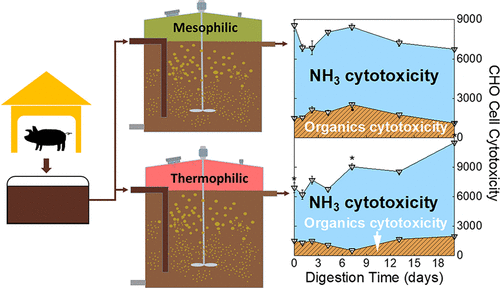当前位置:
X-MOL 学术
›
Environ. Sci. Technol.
›
论文详情
Our official English website, www.x-mol.net, welcomes your
feedback! (Note: you will need to create a separate account there.)
Influence of Anaerobic Mesophilic and Thermophilic Digestion on Cytotoxicity of Swine Wastewaters.
Environmental Science & Technology ( IF 10.8 ) Pub Date : 2020-02-10 , DOI: 10.1021/acs.est.9b07066 Nedal Massalha 1, 2, 3 , Michael J Plewa 3, 4 , Thanh H Nguyen 2, 5 , Shengkun Dong 2, 3, 6
Environmental Science & Technology ( IF 10.8 ) Pub Date : 2020-02-10 , DOI: 10.1021/acs.est.9b07066 Nedal Massalha 1, 2, 3 , Michael J Plewa 3, 4 , Thanh H Nguyen 2, 5 , Shengkun Dong 2, 3, 6
Affiliation

|
Recycling wastewater from animal production for fertilizers using anaerobic digestion (AD) is a common method to recover the nutrients in the digestate. However, the digestate toxicity is not well understood because AD is mainly designed for chemical oxygen demand reduction. This study determined the toxicity during AD and the controlling factors with the goal to improve digestate safety during farmer handling to reuse the nutrients. Thermophilic and mesophilic AD of two swine wastewater sources were studied. Mammalian cell cytotoxicity revealed that the effluent after thermophilic digestion was at least 69% more toxic than the mesophilic effluent, owing to higher ammonia and total organic carbon in the former. Ammonia accounted for >55% total cytotoxicity, and the organics of the thermophilic digestate were twice more toxic than those in the mesophilic digestate. Despite less toxicity contribution than the ammonia, the organics did demonstrate significant adverse effects on the thiol-mediated cellular protection mechanism. For swine wastewater nutrient recovery, converting ammonia to less toxic nitrogen forms could lower the toxic hazard of the AD digestate. With much less ammonia, the organics would be the remaining decisive factor for toxicity, which is favorably reduced using thermophilic AD over mesophilic. If the ammonia is not reduced, mesophilic AD would generate a less toxic digestate.
中文翻译:

中性和厌氧厌氧消化对猪废水细胞毒性的影响。
使用厌氧消化(AD)从动物生产中回收肥料的废水是一种常见的回收消化物中养分的方法。但是,由于AD主要是为减少化学需氧量而设计的,因此对消化毒性的了解还不够。这项研究确定了AD期间的毒性和控制因素,目的是提高农民在处理中重复使用养分时的消化安全性。研究了两种猪废水来源的嗜热和嗜温AD。哺乳动物细胞的细胞毒性表明,由于前者中氨和总有机碳含量较高,嗜热消化后的废水的毒性至少比中温废水高69%。氨气占总细胞毒性的> 55%,嗜热消化物的有机物的毒性是中温消化物的有机物的两倍。尽管毒性比氨低,但有机物确实对硫醇介导的细胞保护机制显示出显着的不利影响。对于猪废水的养分回收,将氨转化为毒性较低的氮形式可以降低AD消化液的毒性危害。如果氨气含量少得多,则有机物将是毒性的决定性因素,与嗜温性相比,使用嗜热性AD有利地降低了毒性。如果不还原氨,则嗜温AD将产生毒性较小的消化物。对于猪废水的养分回收,将氨转化为毒性较小的氮形式可以降低AD消化液的毒性危害。如果氨气含量少得多,则有机物将是毒性的决定性因素,与嗜温性相比,使用嗜热性AD有利地降低了毒性。如果不还原氨,则嗜温性AD将产生毒性较小的消化物。对于猪废水的养分回收,将氨转化为毒性较低的氮形式可以降低AD消化液的毒性危害。如果氨气含量少得多,则有机物将是毒性的决定性因素,与嗜温性相比,使用嗜热性AD有利地降低了毒性。如果不还原氨,则嗜温AD将产生毒性较小的消化物。
更新日期:2020-02-10
中文翻译:

中性和厌氧厌氧消化对猪废水细胞毒性的影响。
使用厌氧消化(AD)从动物生产中回收肥料的废水是一种常见的回收消化物中养分的方法。但是,由于AD主要是为减少化学需氧量而设计的,因此对消化毒性的了解还不够。这项研究确定了AD期间的毒性和控制因素,目的是提高农民在处理中重复使用养分时的消化安全性。研究了两种猪废水来源的嗜热和嗜温AD。哺乳动物细胞的细胞毒性表明,由于前者中氨和总有机碳含量较高,嗜热消化后的废水的毒性至少比中温废水高69%。氨气占总细胞毒性的> 55%,嗜热消化物的有机物的毒性是中温消化物的有机物的两倍。尽管毒性比氨低,但有机物确实对硫醇介导的细胞保护机制显示出显着的不利影响。对于猪废水的养分回收,将氨转化为毒性较低的氮形式可以降低AD消化液的毒性危害。如果氨气含量少得多,则有机物将是毒性的决定性因素,与嗜温性相比,使用嗜热性AD有利地降低了毒性。如果不还原氨,则嗜温AD将产生毒性较小的消化物。对于猪废水的养分回收,将氨转化为毒性较小的氮形式可以降低AD消化液的毒性危害。如果氨气含量少得多,则有机物将是毒性的决定性因素,与嗜温性相比,使用嗜热性AD有利地降低了毒性。如果不还原氨,则嗜温性AD将产生毒性较小的消化物。对于猪废水的养分回收,将氨转化为毒性较低的氮形式可以降低AD消化液的毒性危害。如果氨气含量少得多,则有机物将是毒性的决定性因素,与嗜温性相比,使用嗜热性AD有利地降低了毒性。如果不还原氨,则嗜温AD将产生毒性较小的消化物。









































 京公网安备 11010802027423号
京公网安备 11010802027423号